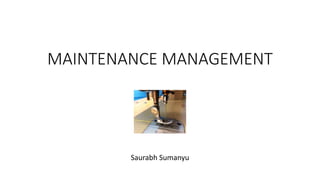
Maintenance of SNLS Machine
- 2. TYPES OF MAINTENANCE PROACTIVE REACTIVE OTHERS a. Preventive Maintenance b. Predictive Maintenance c. Condition- based Maintenance d. Scheduled Maintenance e. Planned Maintenance f. Routine Maintenance a. Emergency Maintenance b. Corrective Maintenance a. Deferred Maintenance b. Total Productive Maintenance
- 3. SINGLE NEEDLE LOCK STITCH (SNLS) MACHINE MAINTENANCE Supplies and Equipments • Pie or cake pan for soaking parts in cleaning fluid • Small screwdriver • Large screwdriver • Small adjustable wrench • Hammer (optional) • Small oil can (clean) for cleaning fluid • Cleaning brush (narrow, nylon) • Paring knife (or pocket knife) • Long needle or small crochet hook • Tweezers • Cleaning cloths • Fabric to test stitching • Can of sewing machine oil (check your machine instruction booklet for the type recommended) • Tube of sewing machine lubricant (check your machine instruction booklet for the type recommended) • Small bottle or can of cleaning solvent that will not flash flame at temperatures below 120°F. (Never use carbon tetrachloride; it is very poisonous). • Newspapers • Plastic wrap (household type) • Rubber gloves • Magnifying glass (optional) • Flashlight (optional)
- 4. MAINTENANCE POINTS FOR PREVENTIVE MAINTENANCE OF SNLS MACHINE
- 5. POINTS TO BE NOTED DURING WORKING HOUR • Check needle point • Check stitch quality • Check oil leakage • Cleaning hook area
- 6. POINTS TO BE NOTED AFTER WORKING HOUR • Check oil level • Remove dust from oil reservoir • Check needle • Check Feed dog, Throat plate, Presser foot and Hook point • Check thread and bobbin winder • Make sure there is no thread between motor pulley and hand wheel • Check electric plug socket position • Check pedal position and needle lifter • Check thread stand position • Check loose screws • Keep small piece of fabric under presser foot
- 7. BENEFITS OF PM OF SNLS • Machine downtime is decreased and the number of major repairs is reduced • Better conservation and increased life expectancy of machine, thereby eliminating premature replacement • Reduced overtime costs and more economical use of maintenance workers due to working on a scheduled basis instead of a crash basis to repair breakdowns • Timely, routine repairs circumvent fewer large-scale repairs.
- 8. SCHEDULED MAINTENANCE OR CALENDAR BASED PREVENTIVE MAINTENANCE OF SNLS MACHINE
- 9. DAILY MAINTENANCE • Clean the machine and machine area • Checkup the threading of the machine • Checkup the oil quality and quantity • Keep fabric at the bottom of the presser foot at the end of the day • Switch of the machines after operation • Check the needle tip and needle bend • Checkup the needle system and size used for fabric and machine
- 10. WEEKLY MAINTENANCE • Check up the oil level and oil colour • Remove the presser foot, throat plate and feed dog and clean properly • Remove the belt guard, motor cover and clean • Adjust hook timing and clearance if necessary • Use emery stone to smoothen the face plate, feed dog, presser foot and hook shuttle and remove the scratches
- 11. MONTHLY MAINTENANCE • Adjust the hook timing and clearance • Pour oil up to maximum level • Checkup oil flow in the pipe and control if necessary • Tighten the screws and nuts of the machine • Check the machine free movement and apply grease if necessary
- 12. QUARTERLY MAINTENANCE • Change the oil if necessary • Tighten the screws and nuts of machine • Check-up any play (blacklash) both main shaft, hook set and gears • Apply grease and oil to gears and cams • Tighten the stand screws and nuts • Tighten the thread stand screws • General servicing has to be done quarterly
- 13. HALF YEARLY MAINTENANCE • Replace the oil filters and oil • General servicing has to be done ANNUAL MAINTENANCE • Throughout inspection of machines required to check all the parts and functionality.
- 14. EFFECTS OF POOR OR NO PM • Seam Quality • Seam Appearance • Seam Durability • Sewing Operator Productivity & Earnings • Sewing Operator Morale • Manufacturing Through-put time • Products produced may require greater inspection • Higher costs and lower profits • Consumer dissatisfaction • Loss of Brand-name credibility • Harm to the operator • Machine life • Harm to the material • Machine breakdown • Increase in reactive maintenance, etc.
- 16. To avoid above mentioned situations, following maintenance schedule chart should be used.
- 20. CONCLUSION • It is hence concluded that the preventive maintenance of SNLS machines is important because it is one of the most important and majorly used machine and the preventive maintenance (PM) helps in protecting the machine from any kind of major breakdown and although the machine may require some reactive maintenance due to extremely unexpected breakdowns but PM helps to reduce the number of reactive maintenance. It also helps in ensuring the quality of the sewn product, and with continuous PM, there is less probability of any kind of hard to the machine, man or material. • Hence, PM is a very important activity to be carried out in an industry and it helps in reducing the wastages and therefore, losses and helps in profit making.
- 21. THANK YOU!